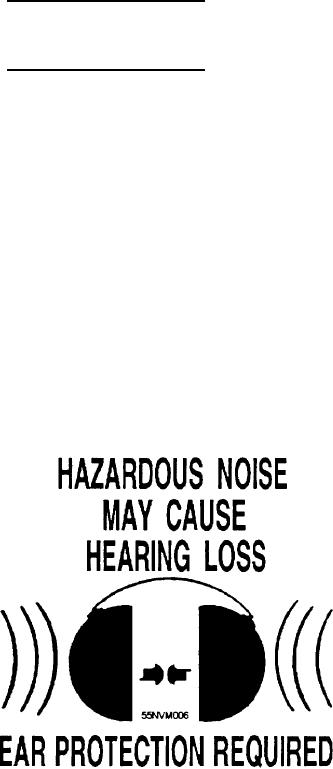
compared to the reference (base line) to determine if a
continuous or intermittent sounds, jet or propeller
hearing threshold shift has occurred.
aircraft, marine engines, and machinery.
Hearing loss has been and continues to be a source
HEARING PROTECTIVE DEVICES
of concern within the Navy. Hearing loss attributed to
occupational exposure to hazardous noise, the high cost
All personnel must wear hearing protective devices
of related compensation claims, and the resulting drop
when they must enter or work in an area with noise
in productivity and efficiency have highlighted a
levels greater than 84 dB. There are many types of
significant problem that requires considerable attention.
hearing protection--inserts of numerous styles
The goal of the Navy Hearing Conservation and Noise
(earplugs) and circumaurals (earmuffs).
Abatement Program is to prevent occupational
noise-related hearing loss among Navy personnel. The
Single hearing protection. Single hearing
program includes the following elements:
protection is required when in areas where the noise
level is above 84 dB.
Work environments are surveyed to identify
Double hearing protection. Double hearing
potentially hazardous noise levels and personnel
protection is required when the noise level is 104 dB or
at risk.
higher.
If environments contain or equipment produces
potentially hazardous noises, they should be
IDENTIFYING AND LABELING
modified to reduce the noise to acceptable levels.
OF NOISE AREAS
Where engineering controls are not feasible,
administrative controls and/or the use of hearing
Industrial hygienists use a noise level meter to
protection devices are employed.
identify noise hazardous areas. All noise hazardous
areas are labeled using a HAZARDOUS NOISE
Periodic hearing testing is conducted to monitor
WARNING decal (fig. 1-16). Post this decal at all
the program.
accesses.
Educating Navy personnel in hearing
You will find further information on hearing
conservation programs is vital to the overall
conservation in OPNAVINST 5100.23.
success.
HEARING TESTING
HEAT STRESS PROGRAM
Heat stress is any combination of air temperature,
All personnel required to work in designated noise
thermal radiation, humidity, airflow, and workload that
hazard areas or with equipment that produces sound
levels greater than 84 decibels (dB) or 140 dB
sound/pressure levels are entered in the hearing testing
program. The hearing testing program includes a
reference hearing test and monitored hearing tests.
Reference (Base Line) Hearing Test
All military personnel should receive a reference
hearing test upon entry into naval service. his test is
called the base line.
Monitored Hearing Tests
If a person works in a noise hazard area, a hearing
test is conducted within 90 days of reporting and
repeated at least annually. Hearing tests are conducted
when there are individual complaints or difficulties in
understanding conversational speech or a sensation of
Figure 1-16.--Hazardous noise warning decal.
ringing in the ears. The 90-day or annual audiogram is
1-25

